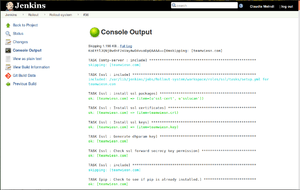Jenkins (software)
 | |
 | |
| Initial release | 2 February 2011[1] |
|---|---|
| Stable release |
2.25
/ 9 October 2016 |
| Repository |
github |
| Written in | Java |
| Operating system | Cross-platform |
| Type | Continuous integration |
| License | Expat[2] |
| Website |
jenkins |
Jenkins is an open source automation server written in Java. The project was forked from Hudson after a dispute with Oracle.
Jenkins helps to automate the non-human part of the whole software development process, with now common things like continuous integration, but by further empowering teams to implement the technical part of a Continuous Delivery. It is a server-based system running in a servlet container such as Apache Tomcat. It supports SCM tools including AccuRev, CVS, Subversion, Git, Mercurial, Perforce, Clearcase and RTC, and can execute Apache Ant and Apache Maven based projects as well as arbitrary shell scripts and Windows batch commands. The creator of Jenkins is Kohsuke Kawaguchi.[3] Released under the MIT License, Jenkins is free software.[4]
Builds can be triggered by various means, for example by commit in a version control system, by scheduling via a cron-like mechanism and by requesting a specific build URL. It can also be triggered after the other builds in the queue have completed.
Jenkins functionality can be extended with plugins.
History
Jenkins was originally developed as the Hudson project. Hudson's creation started in summer of 2004 at Sun Microsystems. It was first released in java.net in Feb. 2005.[5]
Around 2007 Hudson became known as a better alternative to CruiseControl and other open-source build-servers.[2][5] At the JavaOne conference in May 2008 the software won the Duke's Choice Award in the Developer Solutions category.[6]
During November 2010, an issue arose in the Hudson community with respect to the infrastructure used, which grew to encompass questions over the stewardship and control by Oracle.[7] Negotiations between the principal project contributors and Oracle took place, and although there were many areas of agreement a key sticking point was the trademarked name "Hudson",[8] after Oracle claimed the right to the name and applied for a trademark in December 2010.[9] As a result, on January 11, 2011, a call for votes was made to change the project name from "Hudson" to "Jenkins".[10] The proposal was overwhelmingly approved by community vote on January 29, 2011, creating the Jenkins project.[11][12]
On February 1, 2011, Oracle said that they intended to continue development of Hudson, and considered Jenkins a fork rather than a rename.[13] Jenkins and Hudson therefore continue as two independent projects, each claiming the other is the fork. As of December 2013, the Jenkins organisation on GitHub had 567 project members and around 1,100 public repositories,[14] compared with Hudson's 32 project members and 17 public repositories.[15]
In 2011, creator Kohsuke Kawaguchi received a Google-O'Reilly Open Source Award for his work on the Hudson/Jenkins project. In 2014, Kawaguchi became the Chief Technology Officer for CloudBees.[16]
On April 20, 2016 version 2 was released with the Pipeline plugin enabled by default. The plugin allows for writing build instructions in Apache Groovy.
Plugins
Plugins have been released for Jenkins that extend its use to projects written in languages other than Java.[17] Plugins are available for integrating Jenkins with most version control systems and big databases. Many build tools are supported via their respective plugins. Plugins can also change the way Jenkins looks or add new functionality. There are a set of plugins dedicated for the purpose of unit testing that generate test reports in various formats (for example JUnit bundled with Jenkins, MSTest, NUnit etc.[6]) and automated testing which supports automated tests. Builds can generate test reports in various formats supported by plugins (JUnit support is currently bundled) and Jenkins can display the reports and generate trends and render them in the GUI.
Security
Jenkins' security depends on two factors, access control and protection from external threats. Access control can be customized via two ways, user authentication and authorization. Protection from external threats such as CSRF attacks and malicious builds is supported as well.[7]
Awards and Recognition
- InfoWorld Bossie Award (Best of Open Source Software Award) in 2011.[8]
- Received Geek Choice Award in 2014.[8]
See also
References
- ↑ Jenkins 1.396 released, The first release of Jenkins is posted, Kohsuke Kawaguchi
- ↑ "LICENSE.txt".
jenkinsci/jenkins(source code repository). GitHub (published 2011-09-11). 2008-02-12. Archived from the original on 2016-10-18. Retrieved 2016-10-18. - ↑ Dan Dyer. "Why are you still not using Hudson?". Retrieved 2008-05-21.
- ↑ Kawaguchi, Kohsuke; et al. "Use Hudson: License". Retrieved January 30, 2011.
- ↑ Kawaguchi, Kohsuke. "Hudson" (PDF). Retrieved 28 June 2013.
- ↑ "Plugins - Jenkins - Jenkins Wiki".
- ↑ "Securing Jenkins". jenkins.io. Retrieved 2016-09-13.
- 1 2 "Awards - Jenkins - Jenkins Wiki". wiki.jenkins-ci.org. Retrieved 2016-09-13.
External links
| MediaWiki has documentation related to: Jenkins |
- Official website
- Moser, Manfred; O'Brien, Tim (2011-11-25). Hudson free book (PDF). Oracle, Inc.
- Kohsuke Kawaguchi (2011-02-08). "Jenkins creator Kohsuke Kawaguchi on The Changelog podcast talking about the project origin and name change". the changelog. Retrieved 2016-03-03.
- Kohsuke Kawaguchi (2015-02-15). "7 Ways to Optimize Jenkins/Hudson (by its founder)" (PDF). CloudBees. Retrieved 2016-03-03.